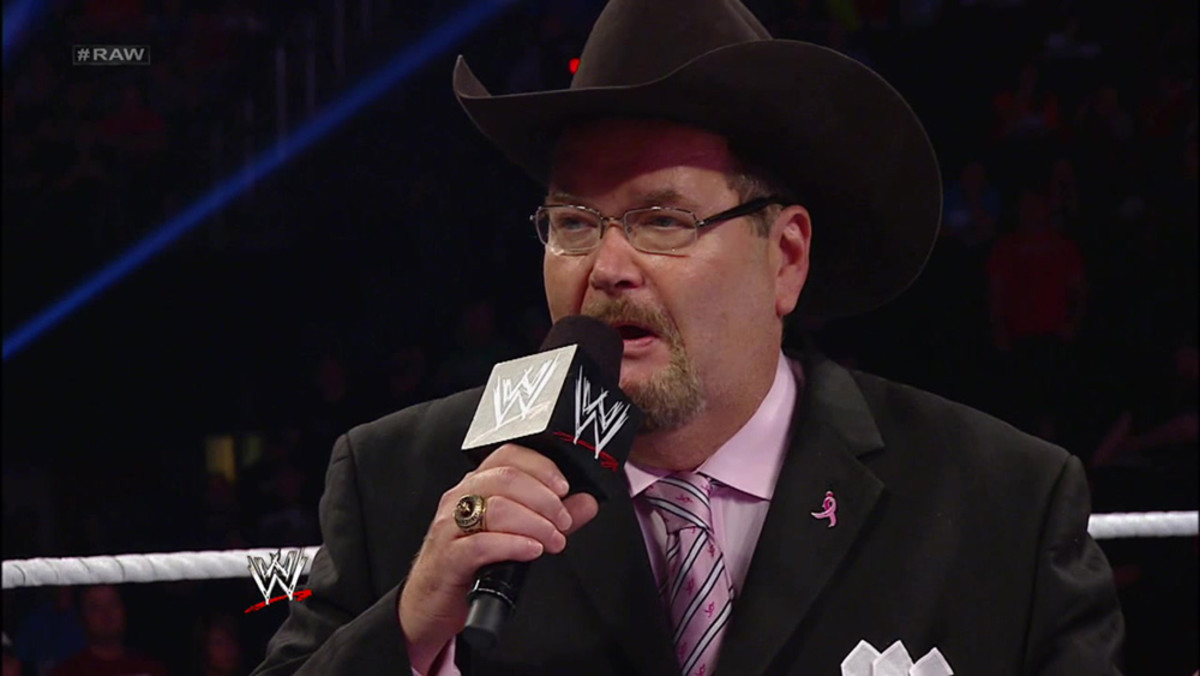Q&A: Jim Ross On His New Book, Paul Heyman's Friendship and Working With Vince McMahon

WWE Hall of Famer Jim Ross releases his new book, Slobberknocker: My Life in Wrestling, next Oct. 3. The book covers Ross’ career in wrestling, as well as reveals some private moments behind the curtain with Vince McMahon in WWE, Paul Heyman in WCW, and ends with his return home to WWE at WrestleMania XV in 1999. Ross connected with Sports Illustrated to discuss his new book, particularly the sections on Vince McMahon and Paul Heyman, as well as touched on whether he was in the running to replace JBL on SmackDown.
SI.com: The beginning of the book includes a foreword from WWE Chairman and CEO Vince McMahon. Although you have known him for decades, is it difficult to ask McMahon for a favor?
JR: Vince was very accommodating, and I appreciated it. I never looked at that as an issue. I wanted him to write the foreword, and I never had any trepidation that he wouldn’t.
There is a letter in the book from Vince that he wrote to me when I was sick with Bell’s Palsy for a second time. I didn’t know it at the time, but I was battling depression. I didn’t want to come out of the house. Vince told me how badly he wanted me to come back to work, and he wrote, “Get the f--- back up!” That might seem abrasive to some, but I knew he was being real and coming straight from the heart. Vince’s letter was a handwritten one that he had somebody from the office deliver to my door, and he let me know exactly how much I meant to him.
Vince was so great at the “Mr. McMahon” character that some people think he wouldn’t want to help people in real life, and that’s just not true.

SI.com: The book weaves together your personal and professional careers in a compelling fashion. One of the stories you shared was about an airplane ride with the “Nature Boy” Ric Flair, who unsuccessfully flirted with the stewardess on the flight. Ric said to you, “Do you really think she’ll go for you after she wouldn’t go for me?” That woman turned out to be Jan, your future wife, who you just lost in a terrible accident this past spring. Was it difficult to look back and share these personal memories?
JR: Jan was in my life for 25 years, and a lot of people don’t realize she was a major part of my success. The fun times were not hard to share, at all. They were real and I lived them in the flesh. Everything is very real and guttural in the book.
When Ric and I were sitting together on that flight, there were four first class seats on that small airplane. Jan worked first class, and she was very engaging and outgoing. She had Flair and I laughing. When I read the audio version of my book, I felt like I was back in that seat. I felt all those emotions; I remember what I drank, the conversation, and Ric being Ric. He wasn’t being unruly, he was being fun. My relationship with Jan started off with fun and laughter, and Ric was a part of that.
There are so many parts of my life connected to wrestling. I met Jan while I was with Ric Flair. I received a collect phone call from Oklahoma telling me that my dad had a heart attack on the night the Road Warriors returned to Monday Night Raw. I went back to work thinking that WrestleMania XV with Austin-Rock I was going to be my last match ever, and I never revealed that to anyone, because of my face and my lack of confidence in my speech and enunciation. All of the pivotal moments in my adult life are connected to the wrestling business.
SI.com: Paul Heyman’s name appears throughout your book, including a chapter that is devoted to him, and it was fascinating to read about your friendship. There was a time in 1991 when Heyman was not the most popular man in wrestling, and it may have benefited you to disassociate from him, yet you fought to get Heyman rehired. Why did you believe in Heyman?
JR: We had more in common than it looks on the surface. Paul is a Jewish kid from Scarsdale and I’m a redneck Okie from Oklahoma. Paul brought out the best in me, even though we could seemingly be very confrontational, so I trusted my instincts. I got to know Paul, especially when he was driving me, as a person and a professional.
Paul had all these guys on the booking committee who were not “Paul Heyman Guys”. They would not have bought that t-shirt. I just thought he should be booked as a villain. The booking committee had already proven that theory, so it seemed so simple enough to me. All I knew was Paul would know how to get talent over, and though we might take different roads to get there, our destination would always be the same.
SI.com: While it is true that the “Monday Night Wars” took place in the 1990s, the territory wars in wrestling intensified in the 1980s. You were a major part of WWE’s success in the ‘90s, but you were an integral piece of the puzzle for the WWE’s opposition in the ‘80s. You wrote about your own marital issues in the mid-80’s, which were occurring at the same time as when Junkyard Dog left Bill Watts’ Mid-South territory. Looking back, was it difficult to fight against WWE?
JR: I wanted the book to be honest. I didn’t want to rewrite history, and I wanted there to be new material. Now I have a lot of blemishes and imperfections in my own life, but my mom and dad taught me to be loyal. So if I’m playing on Bill Watts’ team, I’m damn sure going to be loyal to Watts and everything he’s doing, and I did all I could to make the results he was looking for happen. That was my same mentality when I went to work for Turner, and the same when I went to work for Vince. The difference was the business had a “Loser Leaves Town” feeling when I was working for Vince during the “Monday Night Wars”. We were all amply immersed. My life was WWE. That should never be taken as a negative. I committed to that full process in the “Attitude Era” in front of the camera and behind the camera. I never felt like that was a sacrifice. I felt like I was doing what I was raised to do, and that’s being loyal.
Q&A: KUSHIDA on NJPW vs. ROH, His Top Three Wrestlers and Daniel Bryan's Challenge to Fight
SI.com: You write in the book about announcing sublime matches between Ricky “The Dragon” Steamboat and the “Nature Boy” Ric Flair in 1989, as well as unforgettable battles between “Stone Cold” Steve Austin and The Rock. Were there any similarities between those matches, or were they two very different sets of beasts?
JR: There were certainly similarities because you had excellence in the ring in both those illustrations. I called the Flair/Steamboat matches in ‘89 with three different partners. I worked with Bob Caudle, Terry Funk, and Magnum T.A.
You’ve got to start with Ric. Being in the ring, bell-to-bell and cutting a promo to get you there, Flair is the number one guy. He’s the best ever. Flair really established himself as the best that ever was when he was wrestling in the latter days as the traveling NWA champion throughout the 80’s. In the era he was traveling, across the board, wasn’t the strongest in the history of the NWA. That’s not because of Ric, it was the territories. Some of the talents he worked with may not have been main eventers in any other territories, and I saw firsthand, Ric was able to turn it into something special. Then you have another era with Austin and Rock. Both those eras had different styles, but that was an announcer’s dream. Calling those matches? It was unreal.
That holds true to this day. This year, I’ve called Undertaker-Roman Reigns and three Okada-Omega matches, as well as the Mae Young Classic final. Watching these newer talents evolve is one of the most exciting things about still being in the business. It keeps me fresh.
SI.com: With JBL leaving WWE, there were many people who campaigned for you to replace him on SmackDown Live. Was there any discussion from WWE about returning to SmackDown?
JR: I really do appreciate when people think of me for an opening. If WWE ever needed me to fill in, I would certainly do it with no reservation. Now, is it something I want to do full-time? Absolutely not. It’s a young man’s game, so let’s continue to develop these new guys.
I’m thrilled to have my WWE jersey back. I’m going to do between 30 and 40 dates a year. I am happy to fulfill my obligations. If I’m needed for more, I’m ready, but I do not want to do 52 weeks a year. WWE is going to use me if the weekly U.K. show comes to fruition, and my hope is that I’m involved in that show with Nigel McGuinness.
SI.com: Your book is unique, introducing you as a person to readers but also covering some of the most seminal moments in wrestling as you document this extraordinary career in wrestling. Why do you believe people should read your book?
JR: I don’t know that you’ll find anyone in this business with my role. I’ve been fortunate to have been an administrator, a gopher, a driver, a whiskey buyer, VP, EVP, Senior VP, and the voice of a brand. My book is more relatable to the average guy than, say, Brock Lesnar’s book. How many Brock Lesnars are there walking around on the face of the earth? I’m a fan. I had a very humble upbringing, earned everything I got, and learned how challenging it is in the pro wrestling business. I was a long shot to succeed, and I’m still not supposed to be here. When I was born premature, I wasn’t supposed to be there, either. I’m a wrestling fan with a phenomenal journey. The book starts out that way and ends that way. I think people will be motivated by this book, will want to set goals after reading it, and remember that it is the kiss of death to put limits on yourself. It’s a very emotional book, and I am excited to see how people respond.
Justin Barrasso can be reached at JBarrasso@gmail.com. Follow him on Twitter @JustinBarrasso.
